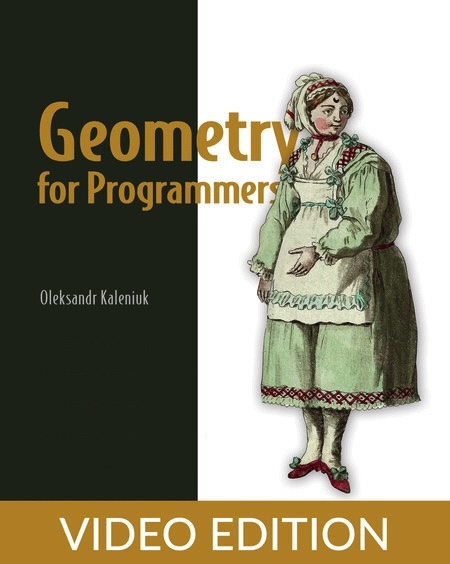
English | MP4 | AVC 1280×720 | AAC 44KHz 2ch | 13h 9m | 1.33 GB
Master the math behind CAD, game engines, GIS, and more! This hands-on book teaches you the geometry used to create simulations, 3D prints, and other models of the physical world.
In Geometry for Programmers you will learn how to:
- Speak the language of applied geometry
- Compose geometric transformations economically
- Craft custom splines for efficient curves and surface generation
- Pick and implement the right geometric transformations
- Confidently use important algorithms that operate on triangle meshes, distance functions, and voxels
Geometry for Programmers guides you through the math behind graphics and modeling tools. It’s full of practical examples and clear explanations that make sense even if you don’t have a background in advanced math. You’ll learn how basic geometry can help you avoid code layering and repetition, and even how to drive down cloud hosting costs with more efficient runtimes. Cheerful language, charts, illustrations, equations, and Python code help make geometry instantly relevant to your daily work as a developer.
Geometry is at the heart of game engines, robotics, computer-aided design, GIS, and image processing. This book draws back what is for some a mathematical curtain, giving them insight and control over this central tool. You’ll quickly see how a little geometry can help you design realistic simulations, translate the physical world into code, and even reduce your cloud services bill by improving the efficiency of graphics-intensive applications.
Geometry for Programmers is both practical and entertaining. Fun illustrations and engaging examples show you how to apply geometry to real programming problems, like changing a scan into a CAD model or developing 3D printing contours from a parametric function. And don’t worry if you aren’t a math expert. There’s no heavy theory, and you’ll learn how to offload most equations to the SymPy computer algebra system.
What’s inside
- Speak the language of applied geometry
- Compose geometric transformations economically
- Craft custom splines for efficient curves and surface generation
- Confidently use geometry algorithms
Table of Contents
1 Getting started
2 What is geometry for programmers
3 Why not let my tools take care of geometry
4 Applied geometry has been around forever; why learn it now
5 You don t have to know much to start
6 SymPy will do your math for you
7 Summary
8 Terminology and jargon
9 Vertices and triangles
10 Lines, planes, and their equations
11 Functions and geometric transformations
12 The shortest possible introduction to matrix algebra
13 Exercises
14 Solutions to exercises
15 Summary
16 The geometry of linear equations
17 Overspecified and underspecified systems
18 A visual example of an interactive linear solver
19 Direct solver
20 Linear equations system as matrix multiplication
21 Solving linear systems with Gaussian elimination and LU-decomposition
22 Which solver fits my problem best
23 3.8 Practical example Does a ray hit a triangle
24 Exercises
25 Solutions to exercises
26 Summary
27 Projective geometric transformations
28 Generalizations
29 Projective space and homogeneous coordinates
30 Practical examples
31 Exercises
32 Solutions to exercises
33 Summary
34 The geometry of calculus
35 Smooth piecewise parametric curves
36 Practical example Crafting a curve out of lines and circles
37 Exercises
38 Solutions to exercises
39 Summary
40 Polynomial approximation and interpolation
41 Polynomial approximation
42 Polynomial interpolation
43 Practical example Showing a trend with both approximation and interpolation
44 Solutions to exercises Exercises
45 Solutions to exercises
46 Summary
47 Splines
48 Understanding polynomial splines and B zier curves
49 Understanding NURBS
50 Exercises
51 Solutions to exercises
52 Summary
53 Nonlinear transformations and surfaces
54 3D surface modeling
55 Using nonpolynomial spatial interpolation in geometry
56 Exercises
57 Solutions to exercises
58 Summary
59 The geometry of vector algebra
60 Dot product Projection and angle
61 Cross product Normal vector and the parallelogram area
62 Triple product The parallelepiped volume
63 Generalization for parallelotopes
64 Exercises
65 Solutions to exercises
66 Summary
67 Modeling shapes with signed distance functions and surrogates
68 How to work with SDFs
69 Some techniques of not-really-SDF implicit modeling
70 Exercises
71 Solutions to exercises
72 Summary
73 Modeling surfaces with boundary representations and triangle meshes
74 Segments and triangles
75 Practical example Contouring with marching cubes and dual contouring algorithms
76 Practical example Smooth contouring
77 Exercises
78 Solutions to exercises
79 Summary
80 Modeling bodies with images and voxels
81 Segmentation by a threshold
82 Typical operations on 3D images Dilation, erosion, cavity fill, and Boolean
83 Practical example Image vectorization
84 How voxels, triangles, parametric surfaces, and SDFs work together
85 Exercises
86 Solutions to exercises
87 Summary
Resolve the captcha to access the links!